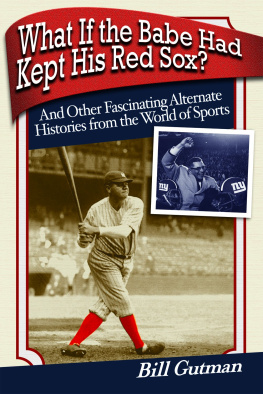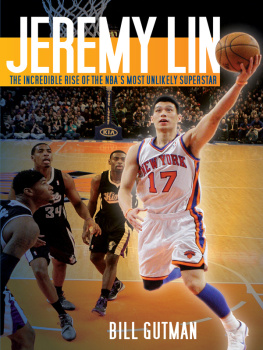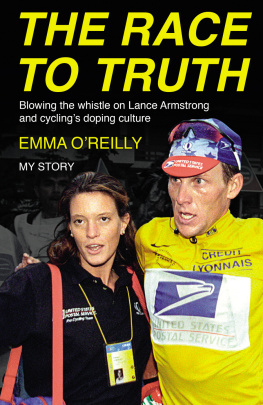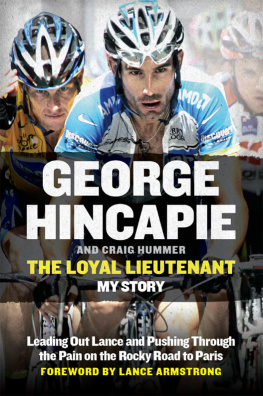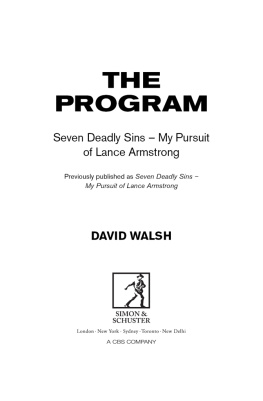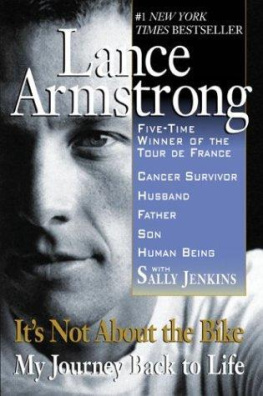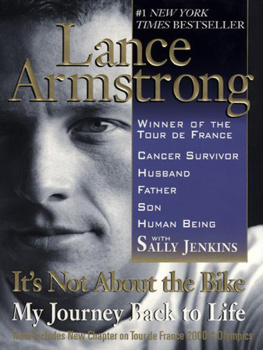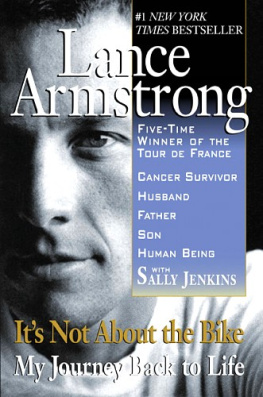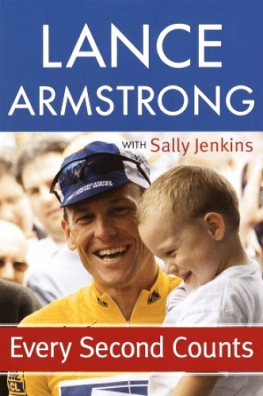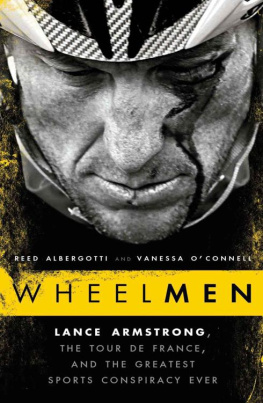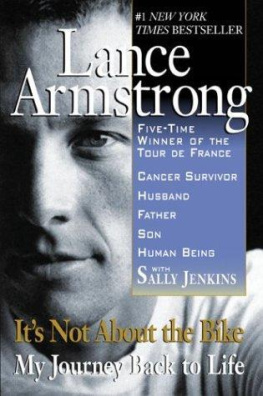If you purchased this book without a cover, you should be aware that this book is stolen property. It was reported as unsold and destroyed to the publisher, and neither the author nor the publisher has received any payment for this stripped book.
A Comeback Begins in Earnest
It was old-fashioned training, the way it used to beno crowds, no frills, just riding and more riding. Lance went out every day and rode in all kinds of weather. The experience brought Lance back to earlier days and he began to just enjoy the act of riding hard, of feeling his body tire, of working against the elements and pressing on. In the evenings the men ate and talked and laughed about old times, all the things that had brought Lance so close to the pinnacle of his sport before his illness had struck. Going to North Carolina was almost like going back in time, when things were much simpler, when Lance would get on his bike and attack, just one man against everyone else.
Also by BILL GUTMAN
Tiger Woods: A Biography
LANCE ARMSTRONG
BILL GUTMAN
SIMON PULSE
New york London Toronto Sydney
If you purchased this book without a cover, you should be aware that this book is stolen property. It was reported as unsold and destroyed to the publisher, and neither the author nor the publisher has received any payment for this stripped book.

SIMON PULSE
An imprint of Simon & Schuster Childrens Publishing Division
1230 Avenue of the Americas, New York, NY 10020
www.SimonandSchuster.com
Copyright 2003, 2005 by Bill Gutman
All rights reserved, including the right of reproduction in whole or in part in any form.
SIMON PULSE and colophon are registered trademarks of Simon & Schuster, Inc.
Designed by Ann Zeak
The text of this book was set in AGaramond.
Manufactured in the United States of America
This Simon Pulse edition October 2005
10 9 8 7 6 5 4 3 2
Library of Congress Control Number 2005932086
ISBN-13: 978-1-4169-1797-7
ISBN-10: 1-4169-1797-7
eISBN-13: 978-1-439-12072-9
To all those people battling a serious illness or other seemingly insurmountable adversity: There is always hope.
Table of Contents
Introduction
At first it was the proverbial feel-good story. An athlete comes back from a near-fatal illness to return to his sport. Then he becomes a champion, winning the sports biggest event, something he couldnt do before becoming ill. And when he triumphs again and again and againseven times in allhe writes one of the greatest sports stories of all time.
The athlete is Lance Armstrong and the event the Tour de France, a three-week-long cycling race that covers more than two thousand miles. Its various stages take riders through the Alps and Pyrenees mountains. The Tour is widely considered the most demanding, debilitating, and grueling sports event in the world, and is the crown jewel of cycling, a race that Europeans have traditionally dominated throughout the years. Then along came Armstrong, who began forging a reputation in the cycling world but was never a real threat to win the Tour. That is, until cancer almost cost him his life.
Diagnosed with testicular cancer in 1996 at the age of twenty-five, Lances life not only changed, it almost ended. Tests soon showed that the cancer had spread to his lungs and brain. His doctors, at the time, gave him a 40 percent chance of survival. Years later, those same doctors said they were being generous. Some felt Lance had no more than a 15 percent chance to live. But he fought back. He found doctors who would utilize a combination of chemotherapy drugs that would not damage his lungs, so he might ride again, and vowed to fight his illness to the end.
His ordeal was long and difficult, but eventually he began to recover. Miraculously, the combination of drugs worked and his body was declared cancer free. By then, Lance Armstrong was already back on his bike and thinking about a return to competition. He began focusing on the one race that gave him problems before his illness: the Tour de France.
Why is the Tour de France considered by so many as the worlds most grueling sports event? For arguments sake, lets compare the Tour with another event that takes tremendous conditioning and endurance: the Ironman triathlon. The Ironman is a one-day event in which competitors begin by swimming 2.4 miles. As soon as they come out of the water, they jump on bicycles and pedal for 112 miles. Once they complete that phase, they get off the bike, change their shoes, and begin running a 26.2-mile marathonwith no rest. Top competitors finish the three phases of the race in little more than eight hours. The Ironman is a test of conditioning, endurance, and will. But how does it measure up against the Tour de France?
With the Tour, not only do riders cover more than two thousand miles and ride up tortuously steep mountains, but they do it day after day. One stage ends, and after a few hours rest the next begins. For three weeks these elite cyclists must ride every day, often in scorching heat, in wind and rain, at high speeds, and always facing the possibility of a dangerous crash. Many riders have failed to finish the Tour, dropping out at various stages.
This happened to Lance Armstrong early in his career. In fact, he was told by his own advisors that he didnt have the body type to win the Tour. He was too big, too muscular, and too heavy for those long, uphill mountain climbs. After recovering from cancer, however, Lances body had changed. He was about twenty pounds lighter and mountain riding became his forte. Once he excelled at the hills, he was tailor-made for the Tour de France.
When I came back [from cancer], Lance explained, I said, If I ever get a chance to do this, Im going to give it everything. Im going to train correctly, eat right, and not going to mess up. Thats why I say all the time that the illness is the best thing that ever happened to me. I would never have won one Tour de France if I hadnt had [cancer]. No doubt.
His first Tour victory in 1999 was miraculous enough, but from there he went on to dominate the event as no one had before. Only one rider, Miguel Indurain of Spain, had won as many as five consecutive Tours. Lance Armstrong would win seven straight Tours before his retirement after the 2005 race. He has not only been an incredible athlete, but an inspiration to cancer patients and survivors the world over. The creation of the Lance Armstrong Foundation and his trademark LIVESTRONG yellow bracelets are just two of the ways he helps inspire people and raise money for cancer research. With all his great athletic achievements, Lance Armstrong has always been about giving back.
Competing in a sport that is barely a dot on the map in the United States, Lance has become a full-fledged sports celebrity, a guy who had all eyes in American turning toward France each July for seven years. Both sports fans and nonfans alike wanted to know how Lance was doing on the Tour. The answer was always the same: Hes winning and he won!
Even today Lance Armstrong considers himself first and foremost a cancer survivor. To that end, he continues to inspire countless others, both directly and indirectly, and in that respect has become not only a sports icon, but a true American hero. His story is widely known, his achievements almost legendary. The strange bedfellows associated with his name will always be cancer and the Tour de France. Ironically, had he been just a champion cyclist with maybe one or two Tour wins, America would hardly have noticed.
But they sure do now.
Next page

